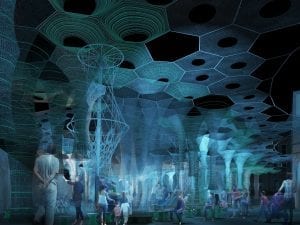A new book from Phaidon highlights contemporary structural theory through celebrated buildings that make use of space as a social connective.
The theory that architecture is a “social condenser”, is an idea first put forward by Soviet architect Moisei Ginzburg in 1928, based on the sense that buildings influence, promote and crystallise social values. Within the context of the Soviet Union, Constructivist building projects were tasked with breaking down hierarchies and creating spaces for communal cohesion. This idea, which has been further theorised and explored more recently by, amongst others, Rem Koolhuis in 2004, is one of the emerging trends evident in the new publication, A+ Architecture:The Best of Architizer 2017, which Paul Keskeys, managing editor, describes as a “barometer of public and critical opinions on architecture. It reveals trends in public perceptions and priorities in relation to the built environment.”
The make-up of the volume takes its social role seriously, and the list is put together through a democratic and open mix of public votes and a critical jury: “There were over 400,000 public votes this year. There are over 100 categories, and judging is based on an open process of selection through online voting. There is also a jury of world-leading figures. Our hope is that any project in the world can win an award and be featured in the book, no matter the size of the firm. It’s fascinating to trace how ideas from architectural theory, which might be seen as abstract and esoteric, become translated into contemporary everyday buildings for people to live and work in,” says Keskeys.
Taking a human-centric approach to ideas of sustainability is central to Jackson Clements Burrows Architects’ Upper House, (2015) in Melbourne, Australia. These 17-storey buildings house more than 100 apartments, and make extensive use of shared communal space and amenities, using the structure to fabricate communities and strengthen a spatial link to its inhabitants. For example, there is a “breezeway” via which inhabitants access their apartments, connecting the outside and inside spaces and creating the opportunity for spontaneous neighbourly interactions. On Level 11 of the building, there is an observatory, and there is a stanza break between the upper and lower floors (the “cloud” and the “podium”); here there is a shared space where residents can relax, read and meet.
As Keskeys remarks, Upper House responds to a more general trend towards negotiating both ecological and anthropological concerns: “Many of the buildings selected this year seem to be attempting to instigate interaction, particularly in the urban environment, which has a long-term reputation for fostering isolation. However, Upper House is a great example that attempts to resolve this problem. The building provokes incidental meetings and promotes a neighbourhood feel.”
Communal space is also integral to Beijing’s Poly International Plaza (2016) designed by San Francisco’s Skidmore, Owings & Merrill LLP (SOM). The project, which offers both offices and commercial spaces, is located between the Forbidden City and Beijing Capital Airport. It uses a blueprint that draws on traditional lanterns, jewels and other vernacular forms to create areas filled with natural light and reflection. Between the exoskeleton, there is a second interior envelope layer, creating dramatic light-filled interior corridors and pathways. These spaces are a continuation of the topographic layout outside of the building and are designed to avoid the estrangement of its inhabitants, instead promoting integration, and providing accommodation for both formal and informal meetings and get-togethers. It is a unique domesticated structure that makes pausing for a quick conversation part of its raison d’être.
Truly representing the “coming together” of people is the spiralling exterior of Ribbon Chapel (2014) by Hiroshi Nakamura & NAP in Onomichi, Japan. This wedding chapel is a visual realisation of the ideal of union through two winding wooden clad staircases outside of a glass chapel structure. The two intertwining staircases, which don’t look binding but rather loosely interwoven, cross each other at various points and mutually support one another: less like the metaphor of a knot, and more like a spontaneous moment in the tying of a bow. Also involving an interaction between two distinct elements of the structure, Bjarke Ingels Group (BIG)’s The Grove at Grand Bay (2016) is a pair of 20-storey contorting towers in Miami, Florida. The structure draws on the local vernacular of condominium developments but physically twists the idea into something which is unexpected and fresh. The two towers rise and bend like long grass; there’s something almost balletic about the interaction of the two: always in parallel and synchronicity, but never occluding each other. The building uses brise-soleil-style balcony shading, extended floorplates and floor-to-ceiling windows to provide panoramic views.
Another trend portrayed in the book is an approach that blends the local and the traditional with the international. This is evident in the University of Pennsylvania’s Perry World House (2016), a remarkable transformation by 1100 Architects of a modest and neglected 19th century residence into a centre for global engagement. The original edifice is rephrased into an international and highly contemporary style but doesn’t lose its touches of traditional American building. Outward-looking values are suggested by the large windows and the upward point seen in the outer frame.
Similarly, shimmering with glass panels strung like a harp, Giovanni Vaccarini Architects’ Headquarters of the Swiss Société Privée de Gérance (2016) is a very recent addition to the historical centre of Geneva. For this project, the architects began with an existing building which they have renovated and extended beyond recognition, transforming it into an environmentally and acoustically advanced space. The façade is astonishingly graphic and precise, an almost pixelated weaving of glass panels and Stahlbau Pichler steel that serves the function of providing shade for the building from the sun, and visually dissolving into the surrounding environment. Above all, it creates cutting-edge working spaces in a way that is efficient and as visually appealing inside as it is out.
A similar set of concerns is evident in one of the unrealised concept-stage projects from the book, nARCHITECTS’ proposal for the Shanghai Library East Hall (2016). This project features interconnected open floors and a variety of public spaces, envisioned to promote flexibility and inclusivity. In an age where libraries in the UK are increasingly under threat, the architects’ vision for Shanghai Library is radical and experimental, involving open floors that connect the library activities to the wider society of the city beyond. Space is divided between compact floors that store a wide range of information formats, and open floors, arranged in pairs, each promoting social interaction, reading, research, and archiving. The floors lead directly out onto the surroundings of the building, in a generous extension of the library into the world rather than keeping separate from it.
Also drawing on traditional and local forms is Compass House (2015), by superkül, which is low to the ground to withstand and respond to the demands of the local environmental conditions and monochrome as a canvas to reflect the changing seasons. Based on the Niagara Escarpment, this low, white structure, discreet to the point of invisible in deep snow, draws on the lexicon of the traditional Native American longhouse, and is settled into its forested backdrop. The living space consists of two perpendicular wings forming a courtyard.
Similarly located in Canada, but drawing on a completely different vernacular tradition, is the Aga Khan Park (2015) in Toronto, designed by Vladimir Djurovic Landscape Architecture and Moriyama & Teshima Planners. This project borrows directly from Islamic architectural styles and decorative palette. Surrounded by a densely planted garden area, the park is a continuation out of doors of the concepts and ideas explored in the Aga Khan Museum and the Ismaili Centre. These aesthetic and sensual gardens are contemporary in style but draw on the principles of traditional Islamic garden design, and in particular the notions of the ephemeral and the long-lasting. Sounds, smells, visual play and a feeling-rich experience of place are all evoked through a loose gravel area punctuated by five water islands made of solid raised black granite in a traditional Islamic geometric arrangement, amongst which is planted an orchard of Amelanchier serviceberries.
The park is an immersive experience, designed to captivate and delight the senses. Aesthetically very different, but with a similar immersive approach is CHROFI’s plan for the Ian Potter National Conservatory (2017) in Canberra. The concept is for the exhibits of the Conservatory to work together with its architecture to create a series of experiences of involving the natural and built environment. Drawing on the latest insulation technology and using a second skin layer, the project dissolves binaries of solid and void, air and water, compression and release, light and dark, natural and manmade. The main exhibit is framed by a void to the sky and outlined by a large cube that appears to hover impossibly overhead. This void is specially designed to provide the appropriate light for tropical plants, whilst limiting any potentially harmful effects which may be caused by solar glare.
One fascinating aspect of the publication is the kaleidoscopic range of scales. Arranged by typology from purpose to stage of realisation, it is sometimes possible to see the same concerns and trends spiralling through small domestic projects such as public parks, huge residential and commercial towers, and large cultural or institutional centres. On a domestic scale, House in Itamambuca (2016), Brazil, by Gui Mattos, draws attention to the liminality of inside and outside space and promotes communality by opening up the living areas.
Likewise, Knapphullet (2014) in Sandefjord, Norway, by Lund Hagem architects, creates a domestic residential and living space emerging out of its rock formations. Whilst this project is small, with space for just two people, it captures the imagination, with its walkable stepped roof, which acts as a ramp towards a viewing platform, and excellent insulation provided by reinforced and water-resistant concrete. The building and the surrounding vegetation work in harmony together. It is easy to see the appeal of reaching impossible vantage points. However, this building also brings about a kind of social condensation as it enacts a non-hierarchical play of continuous surfaces.
Reflecting not only trends amongst architects and scholars of architecture, A+ Architecture: The Best of Architizer 2017 crucially provides an informed vantage point over how the public themselves relate to contemporary buildings, across a comprehensive spectrum of typologies and scales of design.
Colin Herd
www.phaidon.com










